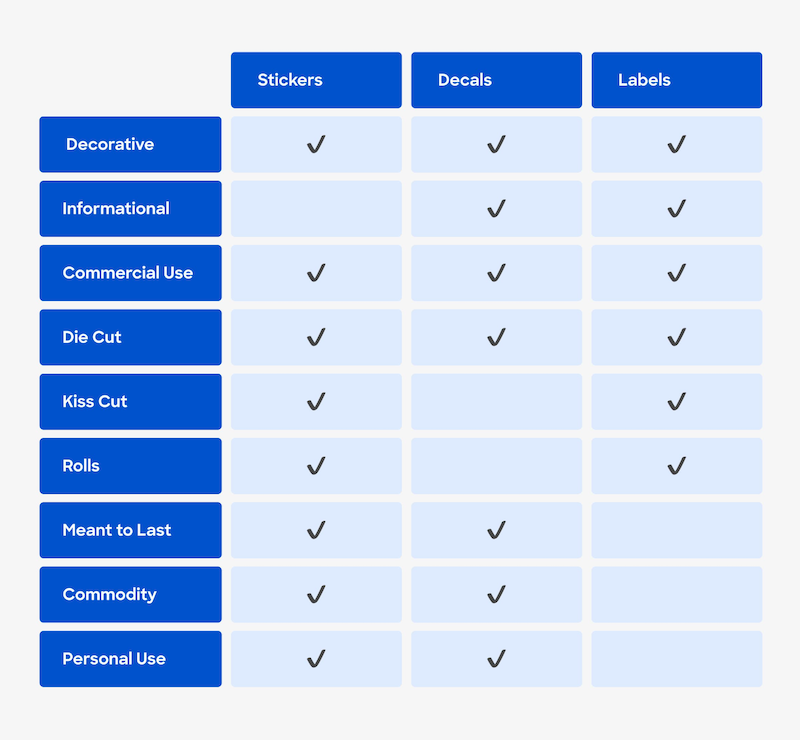Content Menu
● Defining a Sticker, Label, and Decal
● Decal vs. Sticker vs. Label
● Differences in Materials
● Design, Application, and Durability Comparison of Stickers, Labels, and Decals
● Pros and Cons of Each Option
● When to Use Decals, Labels, or Stickers
● Similar, But Ultimately Different
Decals, stickers, and labels may sound similar, but each option differs slightly. And though the difference may be slight in some cases, it can still affect which option is best for which scenario.
In this article, we will define these differences clearly and show you each option’s benefits and disadvantages. By the end, we hope to give you a better understanding of the difference between decals, stickers, and labels so that you can make a more informed decision the next time you use one of these options in your packaging project.
Defining a Sticker, Label, and Decal
Now that you know each option differs from the other, what is a decal? What is a sticker? What makes them different? What are they best for? You might have many questions that now need answering, but let’s first focus on the basic definition of a sticker, label, and decal. A better understanding of each option will allow us to give a much more accurate answer to each preceding question.
To begin, let’s look at the sticker. Custom stickers are small pieces of paper, vinyl, or fabric with an adhesive backing. They are available in various colors, shapes, and designs, making them versatile for branding and decoration.

Decals are similar in that they have a self-adhesive backing but are larger, more permanent, and often used for identification and branding. They are typically made from vinyl, are cut to a specific shape, and have clear backgrounds to blend in when applied to various surfaces.

Finally, custom labels are also a self-adhesive option made from materials like paper, vinyl, and polyester, but their usage is neither for decoration nor identification. They are usually printed with text or images that contain information about a product, its content, or its usage.

As you can see from the above definitions and images, stickers, labels, and decals are similar in that they are all meant to stick to surfaces. Still, their intended purposes are generally different, and these differences don’t end there, so let’s dive deeper.
Decal vs. Sticker vs. Label
We briefly mentioned the different intended purposes for each adhesive option, but they also differ in other aspects. Though there are definitely similarities between the materials used and the types, styles, and production processes, it is essential to note the differences too.
Below, we’ve provided a simple chart to showcase the main differences. However, we will also go more in-depth to give you a complete picture of why stickers, labels, and decals should be considered separate adhesive options.

Differences in Materials
First, let’s look at the materials. We also briefly mentioned materials in the definitions section, but we’ll look at this topic in more detail here.

For stickers, various materials are possible, like glossy paper, matte, vinyl, or fabric. Stickers are the most versatile when choosing materials and have many options for different intended looks, durability, and costs. For example, paper stickers are the most affordable option but are less durable than vinyl stickers.

Decals, however, typically use vinyl materials, which are durable, weather-resistant, and highly customizable with colors and designs. This is necessary as decals are generally much larger and, depending on their usage, can be exposed to more weather elements than stickers.

Labels use similar materials to stickers but are usually thinner for easy mass application onto products. Common labeling materials include Biaxially-Oriented Polypropylene (BOPP), vinyl films, or paper. However, other materials like holographic or metallic are still possible, though rare.
Design, Application, and Durability Comparison of Stickers, Labels, and Decals
Regarding design options, stickers, and labels are very similar. They come in various sizes and have many design possibilities to suit different needs ranging from small and round adhesives to large and rectangular or even full-color printed designs. Both options are also available as a die-cut (cut to the exact shape) or a kiss-cut (cutting the material and leaving the backing paper untrimmed).
Where the similarities end, however, are in their application and durability. Stickers are typically applied manually, whereas labels can be applied manually but are generally mass applied through a specialized machine. On top of this, stickers can last much longer than labels depending on the materials, as labels are produced much thinner to accommodate mass application.

Decals are slightly different. As the largest of the three options and typically exposed to more outdoor elements, they are also the most durable. But unlike stickers and labels, decals are only available die-cut but can be designed in various shapes and sizes to work on surfaces ranging from glass, walls, metal, or sidewalks.

Furthermore, leaning to its more prominent design, applying decals requires manual precision to ensure proper application with no lingering air bubbles. Therefore, it is highly recommended to seek the aid of professionals so that your decal is applied correctly!
Pros and Cons of Each Option
Now that you know the differences between stickers, decals, and labels, let’s examine the advantages and disadvantages to know which adhesive option works best for your next project. Below, we’ve compiled a list of the main pros and cons for each adhesive option:



When to Use Decals, Labels, or Stickers
With the benefits and disadvantages covered, you might still wonder when is the best time to use each option.
Stickers are best used to promote a brand. They are often included in product packaging to encourage customers to decorate their personal water bottles, notebooks, or laptops with your company’s branding. Stickers are also excellent for generating word-of-mouth and can even be sold as an individual product too!
Labels are used in many industries like food, retail, and pharmaceutical industries. They are meant to be put on the product or packaging itself and serve two purposes of brand identification and relaying important product information. Great product labels should attract attention while properly conveying product information to consumers, like expiration dates, ingredients, or usage instructions.
Finally, decals are for advertising a brand or displaying information. Because of their large and durable nature, decals are best utilized on signage, windows, walls, floors, large industrial equipment, or vehicles.
Similar, But Ultimately Different
Decals, stickers, and labels may be similar in some ways, but there are enough differences to warrant considering them separate entities. Each adhesive option has its own benefits, disadvantages, and ideal usage scenarios, so using these terms interchangeably needs to be corrected.
Here at XingKun, we have many options for custom stickers and labels. So if you have any more questions or would like help on your next design project, please contact one of our packaging specialists today!









































